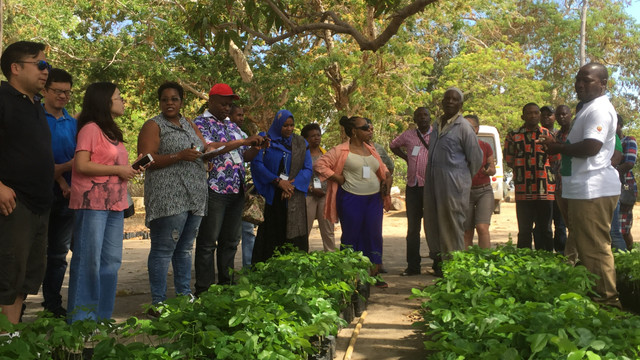Equity, justice and ecosystem services: what do we mean?
Conservation efforts are increasingly supposed to achieve equity – but what does this mean and how can it be assessed? Phil Franks shares some ideas that may help.


A traditional dance festival attracts tourists in Romania's Maramures Nature Park. The park was designed as a multifunctional protected landscape and was zoned to reflect both environmental priorities and economic needs of local people (Photo: Radu Pop/UNDP, Creative Commons via Flickr)
Equity and justice are terms that we increasingly encounter in many different situations. They can be very nebulous and slippery concepts but we can be clearer about what we mean when we look at these concepts in a specific context.
The Natural Resources Group at IIED is taking up this challenge, focusing in particular on the contexts of Reducing Emissions from Deforestation and Forest Degradation (REDD+) and protected areas (PAs) for biodiversity conservation.
To this end, we recently organised an informal meeting of leading academics and actors in REDD+ and PA policy and practice – an 'equity workshop'. The presentations shared at this event (which can be viewed on IIED's Slideshare platform and below) have inspired these few reflections.
Concerns over equity and justice in natural resource management (NRM) and conservation date back to the colonial era. What has changed in the last ten years or so is the extent to which equity and justice concerns have become recognised in the mainstream of NRM policy and practice.
This is very evident in relation to REDD+ in the discourse around "equitable benefit sharing", and in relation to PAs in the programme of work on PAs and Aichi Target 11 of the Convention on Biological Diversity, which both call for greater equity in PA management.
Equity and justice are not entirely interchangeable concepts. From a legal perspective there are some significant differences. In crude terms justice can be characterised as having a stronger focus on recognising and respecting rights as defined in international and national law, while equity has more of a focus on recognising and balancing the rights and interests of different stakeholders.
I should also mention inclusion, which usually implies an emphasis on the rights and interests of social groups that have been tended to be excluded because of gender, ethnicity, poverty and/or other social factors. In plain English all three terms – equity, justice and inclusion – can be regarded as variations on the theme of fairness.
So, coming back to the context of REDD+ and PA conservation, what language do we use in our efforts to promote fairer social outcomes?
Our suggestion is very pragmatic – if equity is currently the language of choice in policy and practice then let's work with this. But even if there are open doors for discussing equity in REDD+ and PA we won't make much progress until we are clearer about what we actually mean by equitable REDD+ or equitable management of PAs.
Three dimensions of equity
Much of the recent work on understanding equity in NRM has focused on ecosystems services and initiatives to better manage and conserve ecosystem services such as REDD+ and various other forms of payments for ecosystem services.
A common framework for understanding equity (and justice) in this context is emerging. This essentially has three dimensions: recognition, procedure, and distribution.
'Distribution' is about the costs and benefits that affect human wellbeing; while 'procedure' is about the inclusiveness of decision-making processes. Less prominent to date, but now gaining more attention, is the dimension of 'recognition' – that recognising stakeholders' rights, interests, concerns and grievances is not just necessary for procedural equity but also key to shaping people's perceptions of equity.
Principles to unpack equity
The three dimensional view of equity is a good starting point, but it doesn't take us much closer to understanding what equity actually means. Equitable in terms of what?
The key to answering this question is to define equity principles. While the three equity dimensions apply in any context, the equity principles will depend on the context.
In the case of REDD+ (and other forms of payments for ecosystem services) quite a bit of work has been done on these principles. As far as we know, nothing similar has been elaborated for the equitable management of protected areas. Participants at the recent equity workshop developed a plan to generate and field test such principles over the next year.
Identifying these principles will be key to understanding and strengthening equity in PA and REDD+ strategies, and to identifying key questions/indicators that we can use to assess progress.
In the distributive dimension they enable us to distinguish different (often competing) objectives – in short whether investment in local communities should be designed to:
- Reward communities contribution to environmental goals, and/or
- Compensate costs they incur (e.g. human wildlife conflict), and/or
- Reflect property rights (i.e. benefits go to those with resource rights), and/or
- Reduce poverty.
When people talk of a "pro-poor”" approach this generally means an approach that prioritises poverty reduction, although even then there are different interpretations of "poor" – are we talking about people below a certain national poverty line or the poorest of the poor?
Analysis of how equity in REDD+ has been discussed in major newspapers of some of the big forest countries shows that equity in the public discourse on REDD+ is mainly interpreted in terms of livelihood benefits. This neglect of the cost and reward elements of an equity equation is also common with PA conservation.
Assessing equity
Of course the big question in many people's minds is how to assess equity, and the success of efforts to improve it. A first point is that there can never be one single universal equity indicator since equity means different things to different people.
However once equity is unpacked into its constituent principles then we should be able to develop a set of indicators drawing on experience in project monitoring and evaluation and performance standards (e.g. the FSC standard in forestry).
Another key point emerging from the equity workshop was that assessing equity is not about assessing whether a particular scheme has met some pre-defined standard of equity (i.e. has reached an equitable end-state) but should focus on whether there have been improvements over time. Not least because perceptions of equity change over time.
Where do we go from here?
In terms of REDD+, we hope that our workshop discussion will help inform an already fairly well established debate on equity in REDD+ and equitable benefit sharing.
IIED is already actively engaged in this with a programme of action research in Mexico and Peru in partnership with the International Union for the Conservation of Nature (IUCN) that aims to understand how equity is interpreted in these two contexts, and aims to use this understanding to help strengthen REDD+ strategies in the two countries.
In terms of protected areas our starting point will be the initiatives that are already aiming – at least as an important secondary if not primary objective – to promote greater equity in the establishment, management and governance of PAs. These include PA governance assessment, PA management effectiveness evaluation, the IUCN Green List, the Whakatane Mechanism, and Social Assessment of PAs (which is currently led by IIED).
An ad-hoc group of workshop participants with a particular interest in this area and other key stakeholders will engage over the next 12 months in a process of developing the equity principles for the three dimensions. The resulting 'equity framework' will then be tested at selected field sites.
This discourse about 'equity' is very much work in progress. For more on equitable PA management watch this space.
Phil Franks (phil.franks@iied.org) is a senior researcher on biodiversity in IIED's Natural Resources Group.
Further resources:
This discussion paper on equity in REDD+ includes a number of key references.
The following presentations are available via Slideshare:
- Addressing equity and poverty in conservation, Dr Helen Schneider, director conservation, livelihoods and governance at Fauna & Flora International
- Balancing equity and efficiency in PES, Meine van Noordwijk, Beria Leimona, Sara Namirembe, Peter Minang
- Concepts and measurement of fairness of green economies – what can we learn from international development experience?, Maryanne Grieg-Gran
- Nepal's community forestry (CF) and lessons on equity, Nya Sharma Paudel, ForestAction, Nepal
- Equity and REDD+ in the media: a comparative policy discourse analysis, Monica Di Gregorio, Maria Brockhaus, Tim Cronin , Efrian Muharrom, Levania Santoso, Sofi Mardiah and Mirjam Büdenbender, CIFOR, CGIAR, University of Leeds, Thinking beyond the Canopy
- Equity, justice and wellbeing in ecosystem governance in Mexico, Juan Carlos Carrillo, Centro Mexicano de Derecho Ambiental
- Equity in international (environmental) law: findings and questions about fair and equitable benefit-sharing, Elisa Morgera, Annalisa Savaresi, Elsa Tsioumani and Louisa Parks, Edinburgh Law School and the University of Lincoln
- Just ecosystem governance: a 'justice-as-recognition' framing, Adrian Martin, University of East Anglia
- Protected areas... equity and equitability – a quick review of CBD decisions on protected areas, Trevor Sandwith, IUCN
- Equity in Protected Area conservation. Lessons from Bwindi Impenetrable National Park-Uganda, Medard Twinamatsiko, social research leader, Institute of Tropical Forest Conservation (ITFC) – Mbarara University of Science and Technology (MUST)
- Social equity matters in Payments for Ecosystem Services, Unai Pascual, Basque Centre for Climate Change
- What is human wellbeing? A locally driven, three-dimensional perspective, Emily Woodhouse, WCS/UCL/Imperial College
- Rights, poverty, equity in conservation, Dilys Roe, IIED
- Links between justice and wellbeing in protected area management in Laos, Neil Dawson, International Development, University of East Anglia
- Understanding links between ecosystem services/governance and human wellbeing: reflections on conceptualisation and operationalisation, Frank Vollmer, School of GeoSciences, University of Edinburgh
- REDD+ and the 'do no harm' principle: a retreat from justice?, Kimberly R. Marion Suiseeya, Department of Political Science, Purdue University
- Evolution of equity/fairness discourses in REDD+, Maria Brockhaus and partners, CGIAR, CIFOR
- Safeguards and standards for equity in REDD+, Phil Franks, IIED/REDD+ SES Secretariat
- What is equity and who decides?, Kate Schreckenberg, University of Southampton, and project partners
Phil Franks (phil.franks@iied.org) is a senior researcher within IIED's Natural Resources Group.
This work is funded by UKaid and the Darwin Initiative but the views expressed do not necessarily reflect those of the funders.




